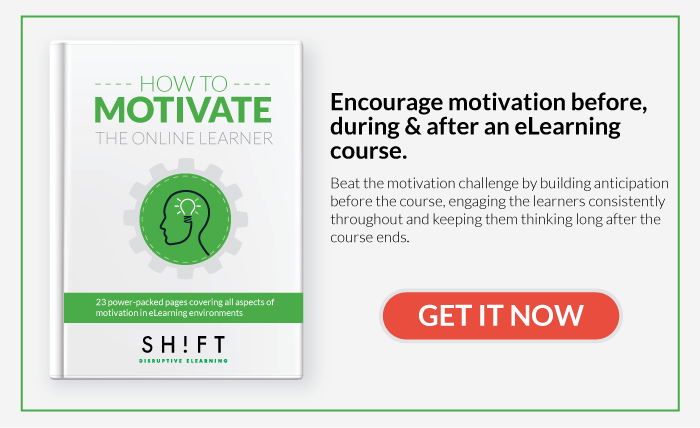Ever found yourself standing at the crossroads of ambition and reality, particularly when it comes to eLearning? You took that leap of faith, fueled by the latest buzz or perhaps a compelling article you chanced upon, and decided to introduce eLearning in your organization. But, instead of the applause and triumphant results you envisioned, there was a whisper of disappointment and a lingering question: “Why isn’t this working?”
Let’s get one thing straight: eLearning isn’t just a trendy box to check off or a badge to wear. It’s a strategic, potentially transformative tool that, when wielded correctly, can revolutionize how your team learns and grows. But if you're feeling a tad disheartened, thinking you've bitten off more than you can chew, fret not! We're here to demystify the maze of eLearning.
If you’ve been looking at your program, scratching your head and feeling a tad helpless, you're in the right place. Let’s dive into the heart of the matter and explore the reasons why your eLearning programs might be missing the mark.
1) A Cloudy Vision: Not Defining Business Goals and Success Metrics
Imagine investing time, energy, and resources into creating a stellar eLearning course, only to find it veering off-course because there wasn’t a defined destination. Before the first course is even drafted, it's vital to gather your team and crystallize what you're hoping to achieve. Is it an 80% employee participation rate within the first quarter? Is it a tangible boost in sales metrics after course completion?
Actionable Insight: Begin with a "Strategy Session". Here's how:
-
Brainstorm with Clarity: Discuss the overarching business objectives you're aiming for. Remember, a goal without metrics is just a wish.
-
Quantify Your Vision: Metrics matter! Whether it’s aiming for a 90% course completion rate or a 15% increase in product knowledge, get specific.
-
Cost-Benefit Analysis: While you're at it, consider the costs associated with your eLearning program. Ensure that the expected results justify the investment.
-
Course Design Alignment: Now, with clear objectives in hand, tailor your eLearning course to directly serve these goals. If boosting sales is the end game, then modules on product knowledge or persuasive communication might be key.
For a deeper dive, follow this guide on designing eLearning programs in sync with business objectives. Here's to making every course count!
Also read: Why Aren’t Employees Completing Your eLearning Courses?
2) The Myth of "Copy-Paste": Transferring Content Doesn’t Equal eLearning Success
Think of eLearning as its own universe. While classroom training is like Earth with its specific conditions and atmosphere, eLearning is more akin to Mars – a place with different dynamics, opportunities, and challenges.
Simply shuttling content from one to the other without adapting to the new environment is a recipe for, well, lack of oxygen (and engagement!). A lecture that thrives in a room full of attentive faces might not have the same vitality on a digital platform where distractions abound.
Actionable Insights:
-
Contextualize Your Content: Understand that eLearning isn’t just a different platform; it's a different context altogether. Delve into the psyche of an online learner. What do they need? How do they engage?
-
Assess Content Relevance: Start by revisiting the core content. What is truly vital? Trim the fluff and focus on the essentials.
-
Maximize Digital Features: Don't just adapt, thrive! Spice up your content! Interactive quizzes, animations, simulations, or even quick polls can make your eLearning modules engaging and memorable.
-
Adapt, Don’t Copy: Reshape your content to fit the mold of eLearning. This might mean re-scripting, re-designing, or even re-thinking your training from the ground up to make it suitable for online consumption.
-
Tailor to the Platform: If your audience is primarily mobile, ensure your content is bite-sized, visually appealing, and easy to navigate on smaller screens.
-
Feedback Loops: Incorporate mechanisms for real-time feedback, like chatbots or forums, which can simulate the instant Q&A advantage of classroom training.
Think of it as more than just a content transfer; it's a total content metamorphosis, ensuring it's crafted and curated for the digital realm. Dive deep, experiment, and transform for the ultimate eLearning success!
Read more: Moving Your Existing Training Content to eLearning - A Step-by-step Guide to Successful Conversions
3) The Absence of a Vibrant Learning Culture
Creating a fantastic eLearning program is a lot like planting a seed. Without the right environment, even the most promising seeds might not sprout.
To ensure your eLearning program not only takes root but truly blossoms, you'll need fertile soil: a robust learning culture.
Actionable Insights:
-
Leadership Backing: Like sunlight for our plant, leadership support is vital. Ensure you have a prominent advocate or sponsor at the executive level. This champion can provide the necessary resources, visibility, and momentum. Make them an integral part of your eLearning journey from day one.
-
Strategic Communication: Just publishing your course and hoping for the best is like watering a plant once and hoping it thrives. Develop a well-planned communication strategy. Highlight the course’s benefits, align it with organizational goals, and keep the excitement alive with regular updates. Set out a clear communication timeline, so everyone knows what to expect.
-
Practical Application Opportunities: Allow your employees to be more than just passive learners. Create spaces and opportunities where they can actively practice, apply, and showcase their newfound skills. This could be through workshops, project opportunities, or even mentorship programs.
-
Support and Mentorship: Water your budding learners with regular support. Introduce mentoring programs, peer-learning groups, or even regular feedback sessions. This ensures that learning doesn't end at the course completion badge but translates into real-world expertise.
Remember, an eLearning course isn’t just about the content or the platform. It's about cultivating an environment where learning is not just encouraged but celebrated.
Also read: The Google Way of Building A Strong Learning Culture
4) The Oversight: Not Tuning Into Your Employees' Training Pulse
Imagine serving a gourmet, five-course meal when all someone wanted was a comforting bowl of soup. That’s the eLearning equivalent of creating a visually stunning, tech-savvy course without aligning it with what your employees truly crave and need.
Sure, it might look fancy on the outside, but if it doesn't satiate the learner's appetite for growth and relevance, it’s not doing its job.
Feedback like “irrelevant” or “time-wasting” isn’t always a critique of your course's quality, but often a sign that it isn’t resonating with their professional aspirations.
Actionable Insights:
-
Feedback Forums: Start by holding regular feedback sessions or surveys to gather insights on what your employees feel about current training programs and where gaps might exist.
-
Skill Gap Analysis: Align with department heads to conduct a skill gap analysis. Understand where your employees stand today and where they need to be for future roles and projects.
-
Tailored Course Design: With feedback and data in hand, craft courses that bridge the gap between current skills and desired outcomes. Ensure the content directly corresponds with both employee aspirations and business objectives.
-
Iterative Approach: Post-launch, regularly revisit your course's impact. Are employees finding it more relevant now? If not, iterate based on new feedback, ensuring the course remains aligned with evolving needs.
The success of an eLearning program isn’t measured merely by its aesthetic appeal or technological prowess but by its resonance with the learners. Keep their needs at the forefront, and you'll craft a course that's not just consumed but cherished.
Read more: DON'T Skip the Training Needs Analysis! Here's Why
5) The Misconception: "Launch and Leave" Instead of "Launch and Live"
Picture this: You’ve planted a beautiful sapling. But instead of nurturing it, you walk away, assuming it'll grow into a majestic tree on its own. Similarly, merely launching an eLearning course doesn’t mean your work is done. Think of it as a continuous journey, where the course evolves with feedback and insight to serve learners better.
Believing that course deployment is the final step can risk the value and impact of the entire program. Post-launch is a crucial phase where you ensure that the course's real-world application aligns with those initial objectives and truly benefits the learners.
Actionable Insights:
-
Data Monitoring: Use analytics tools to keep a close eye on student engagement and performance metrics. Are they completing modules? Which sections see more drop-offs? Insights like these can guide your refinements.
-
Regular Check-ins: Schedule periodic touchpoints, be it through surveys, forums, or feedback sessions. This keeps you in the loop about what’s working and what’s not.
-
Optimization Runs: Based on feedback and data, make iterative improvements to the course. Perhaps a module needs clearer instructions, or an interactive element isn't user-friendly. Address these issues in real-time.
-
Revisit Business Goals: Remember those objectives you set? Regularly compare the course outcomes with these goals. If there's a discrepancy, delve into the "why" and "how" to bridge the gap.
Your eLearning course is a living entity, ever-evolving and adapting. Being hands-on and responsive post-launch ensures that you're not just releasing a program into the wild but guiding it to flourish and make the intended impact.
Must read: Now What? Five Things You Should Do After Launching Your eLearning Course
Also read: How to Create an eLearning Course in 12 Steps
Your eLearning programs aren’t just tools – they're extensions of your organization's commitment to growth, learning, and excellence. Like any ecosystem, they need the right conditions to flourish.
Sometimes, it's easy to lose sight amidst the buzz of technology and content creation, but it's essential to remember the heart of the matter: the learners. If they’re thriving, so will your program. If they’re struggling, it's a signal to re-evaluate and adapt.
So, let's recommit! Roll up those sleeves, take a magnifying glass to your courses, and determine where adjustments can make the most significant impact. Perhaps it's in the content, maybe it's the delivery method, or perhaps it's in post-launch support. Whatever the gaps, recognize them as opportunities waiting to be seized.
By consistently assessing, refining, and elevating your eLearning programs, you're not only ensuring better results but also forging a legacy of continuous learning and excellence within your organization. Let’s turn those eLearning ambitions into tangible successes and craft courses that don’t just tick boxes but transform lives!



